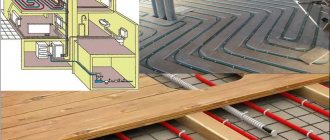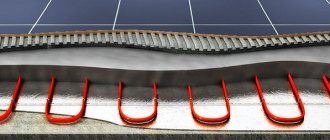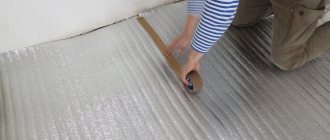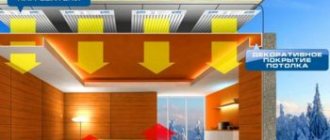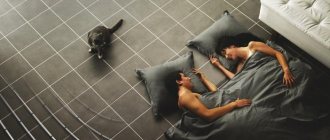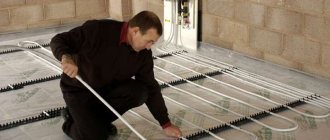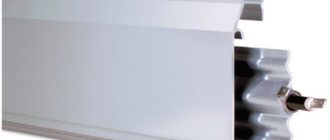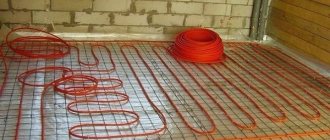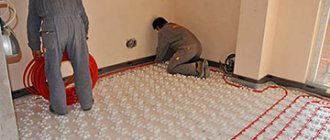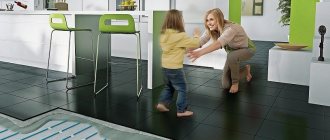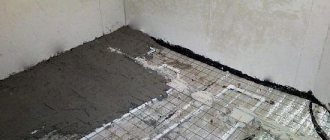When can you turn on the heated floor after laying the tiles?
Any tile materials are hygienic, aesthetically pleasing and durable. The tile holds heat well, but also takes a long time to warm up, especially with classic home heating. There are also rooms, bathrooms and toilets, where the tiles will always be cold. Additional heating in the form of underfloor heating will be a relevant solution to the problem.
A beautiful and smooth tile coating can be obtained by preparing a strong and even surface for laying it. In addition, do not forget that the mass of tiles and porcelain stoneware is significant. Eg:
- 1 m² of tiled floor tiles will weigh 15-25 kg/m²;
- 1 m² of porcelain stoneware weighs much more – 20-45 kg/m².
To support such a weight, a powerful, well-equipped concrete base is needed. A concrete base laid on a heating cable or water pipes can prevent deformation of heating system elements due to the weight of the floor covering. A well-seasoned concrete screed forms strong protection around the embedded parts and prevents the top coatings from exerting force on the internal elements.
Warm floors laid under tiles, massive structures and not every ceiling of a multi-story building can withstand it. For example, in Moscow and other cities with historical buildings, such work is equated to redevelopment and must be approved. The weight of an electric heated floor with porcelain stoneware flooring reaches 100-120 kg/m². Hydronic heated floors will be even heavier.
When will the screed dry?
When it is planned to install the system, installation is carried out on a flat plane. If it has horizontal curvature, then it is corrected using a screed. The optimal layer of leveling mixture depends on the angle of difference and varies between 30-50 millimeters. To create a screed, a cement-sand or concrete mixture is used.
Since cement of any brand requires several days to harden, the thicker the layer, the longer the mixture will dry. However, it is worth remembering that for subsequent installation of the “warm floor” system, plasticizers and other additives are added to the solution to ensure a high thermal conductivity coefficient.
Drying must take place under certain conditions - air temperature +25 ⁰C and moisture level in the environment within 60-70%. In this case, the “maturation” of the floor with installed heating will take about 30 days. You cannot turn on the heated floor too early after pouring. During this time, the tile adhesive and grout will also dry.
How long after you can turn on the heated floor after pouring the screed?
Installing a heated floor with a tile finish is labor-intensive, but worth the effort. So, you can start thinking about when you can turn on the heated floor after laying porcelain tiles after the screed has finished curing.
Initially, the floor slab is prepared. The existing old coating is completely removed, the rough surface is cleaned and leveled. You need to try to avoid large horizontal level differences; some of it is compensated by the screed and adhesive layer, but the concrete will take longer to dry. Sometimes you have to make a rough concrete layer; its thickness should not be less than 30 mm, otherwise the concrete will crack.
Thermal insulation material is laid on the prepared slab to prevent heat loss through the lower plane. Thermal insulation and waterproofing, in most cases, are produced in the form of film building materials. Therefore, the poured concrete mixture is called a “floating screed”, since the concrete does not have direct contact with the level of the floor slab and the walls.
The maximum thickness of this structure is 40 mm. Concrete gains strength by about 10 mm in one week, so you can calculate how many days after pouring the screed you can turn on the heated floor, it will be approximately 28 days.
According to the drawn up diagram, a heating cable or water pipes are laid out on the thermal insulation layer. The heating system is being checked to correct flaws. A concrete solution is prepared in proportions depending on the brand of cement.
For a “floating screed” it is recommended to use cement grade 300, which is inexpensive and has good binding properties. It is best to take river sand, well sifted and without sandy loam or clay. Plasticizers are added to cement and sand in a ratio of 1:3, which improve the technical characteristics of concrete. Add water to the prepared dry mixture, approximately half the resulting volume of powder.
Cooked to the consistency of thick sour cream, the concrete is laid out on the floor and leveled according to the rule. The horizontal deviation is allowed no more than 0.2% of the length of the room with a maximum deviation of 20 mm or, more stringent requirements - 2 mm per 2 m. Such manipulations require professional tools and appropriate skills.
The first ten days after laying the screed, it requires careful supervision. If the humidity in the room is below 50%, then the concrete is covered with polyethylene. Drafts and sudden temperature changes are unacceptable; it is optimal to keep the temperature around +25 °C. Forced removal of moisture is possible no earlier than 21 days. Specialists carrying out construction work monitor the humidity level of the screed using hygrometers. But, 28 days is not the final period when you can turn on the heated floor after pouring the screed. The final finishing of the room with tiles is still ahead.
Design Features
For durability of the coating, make a screed under the heated floor and above it
When laying ceramic tiles on a heated floor system, you should remember a few points. Even before installation begins, you need to perform all the necessary calculations to be sure that the tiles will not exceed the level of the finished flooring in other rooms.
This means that you should think over and select the correct diameter of the pipes of the purchased structure. In some cases, the thickness of the screed layer on which the heated floor is laid increases, in other cases it is necessary to make grooves to deepen the structure.
To build a high-quality floor covering, you will need to make a screed both under the heated floor system and above it.
To fill the screed, you must use a cement-sand mixture or an adhesive composition.
Experts say that screed made from tile adhesive is characterized by increased strength.
When performing work using an adhesive composition, special attention must be paid to the uniform distribution of the substance and the absence of air pockets.
After pouring the screed and laying the tiles, leave the floor to dry for 3 to 5 days
Tile adhesive must be evenly distributed over the surface to protect the structure from subsequent cracking and premature destruction.
The drying time for the screed after pouring will be several days. The composition gains strength within 3-5 days, after which you can begin laying tiles.
Related article: Heat-resistant painting: choosing a protective and aesthetic coating for the fireplace and stove
To begin with, measure the area of the room and make a preliminary layout, selecting a pattern. Then a layer of tile adhesive is applied to the screed, on which the first row will be laid. Work with glue using a notched trowel and trying to lay the tiles on a layer no more than 0.5 cm thick.
For heated floors, special floor tiles are chosen, usually porcelain stoneware.
It retains heat longer and gives off heat well.
The work is carried out using crosses, which guarantee the creation of smooth seams and the absence of unwanted joints.
Lay out the surface only with whole tiles, leaving a gap near the walls, where the “undercuts” will be laid later.
Laying tiles on a prepared screed
An adhesive that is resistant to temperature changes is selected. The recommended thickness of the adhesive layer is approximately 1 cm, for the proportional distribution of heat waves over the tile area. The surface of the screed is primed twice to increase the adhesion of the glue. Remains of waterproofing materials protruding above the screed along the perimeter of the walls are carefully removed.
The tiles are marked according to the selected pattern and the adhesive is mixed according to the recipe. The glue is thoroughly mixed with a construction mixer and its quality is checked. The solution should stay on the spatula when tilted. If there is no practice in laying tiles, mix the adhesive mixture in small portions to prevent it from drying out.
The infused adhesive is applied to the surface of the tile and floor with a notched trowel to enhance adhesion. It is recommended to lay out the drawing from the middle of the room, this way the proportions of the ornament are better respected. The protruding adhesive is immediately removed. The period of complete setting of the glue is about a week.
Summary: We calculate how long it takes to turn on the heated floor after laying the tiles - 28 days for the concrete screed to gain strength of 40 mm, 7 days for the tile adhesive to reliably set, a total of 35 days.
Approximate terms of inclusion
For example, you installed a heated film floor or thin heating mats on an old base, without a concrete screed.
Tiles were laid on top. In this case, before putting the heated floor into operation, it is enough to wait about 2 weeks; the exact drying time for the tile adhesive is indicated on its packaging. Just don't turn it on at full power right away. At first, a small heating of 25˚C is enough, increase the temperature gradually over the course of a week. In the case of cement screed, the timing of inclusion is significantly delayed. First you need to wait until the subfloor is completely dry. Then the heating cable is laid and the solution is poured on top. It must dry completely or, as builders say, “mature” within 4 weeks.
Sometimes there is an opinion that heating the floor will only speed up its drying. Therefore, some turn on the heating little by little during the period when the cement is still wet. But this is fraught with unpleasant consequences. Due to premature heating, air bubbles may appear in the concrete, and due to porosity, the risk of cracking and destruction of the screed will increase. In turn, this leads to overheating of the cable and its premature failure.
If the tile adhesive is not completely dry, due to the increase in temperature, the moisture from it will quickly evaporate and the tile will come off.
How to properly start the heating system after the rough screed has dried: 1. Turn on the system at a low temperature, not higher than 35˚C and maintain it for 3 weeks. 2. A couple of days before laying the tiles, turn off the heating so that the floor temperature drops to 25˚C or slightly lower. 3. After laying the tiles, wait another 3 weeks for the adhesive to harden securely.
Now that all the solutions have gained so much strength, you can gradually put the system into operation. It is possible to slightly reduce the tedious wait if you carry out the work in the warm season. Then the screed will dry faster. However, if it is too hot, its surface will have to be moistened regularly so that the cement dries evenly throughout its entire thickness.
Of course, heated floors can be used for a short time, and should even be turned on immediately after installation. After all, it is necessary to check the correctness of its assembly before it is filled with screed. But in this case they turn it on for a short time and at low power so that the concrete under it does not have time to heat up.
If you still cannot finally decide after what time you can turn on the electric heated floor, contact a professional for advice. They will tell you how long you need to wait so as not to damage the screed, heating system and flooring.
Features of ceramic coating
The time it takes to lay tiles on a heated floor system will depend on the area of the room. One person can easily handle a 3*3 meter bathroom during the day. It is very important that you have all the necessary materials and equipment on hand.
There are basic points that you should know before laying tiles on a warm floor.
- The floor level along with the tiles should be on the same level as the floor in other rooms of the apartment. This suggests that all calculations should be made in advance. Much will depend on the pipes that are used in the work, all the components. If there is a threshold, then a slight difference in floor level heights will not be so noticeable. Most often, this will be necessary to level the surface and place all communications at the base.
- The layer of screed or tile adhesive should be at least 10 mm. This is necessary so that the heat is distributed evenly over the entire plane. Otherwise, the heat concentration will be noted only at the locations of the pipeline.
- There should be no covering of the floor during operation, or crowding the area with furniture, plumbing or other equipment. This item is especially important if you need to lay a rug in the bathroom. If you bypass this rule, then the heating elements will burn out under these areas. It is very important to carefully plan the location of all bath components in the apartment in order to save money. After all, in areas where furniture or other appliances are located, installation should not be done.
When the time comes to lay tiles on the heated floor, you should check several times whether the system is connected correctly and the pipeline is laid. Some will think that this can be skipped and will even laugh. The specialists performing the work will not always do everything efficiently. This is especially evident if total control is not exercised over them. The consequences can be the most dire.
In addition, it is worth paying attention to the fact that all communications of the underfloor heating system are hidden. They should not appear or appear anywhere. The surface on the floor must first be leveled with a screed. If the heated floor was recently poured with concrete, you will have to wait until the solution dries completely. Otherwise, you will have to start the work all over again and correct errors.
All that remains is to take steps to select the tiles. It can be completely different. The best option is ceramic. As for the adhesive composition, it must be intended for heated floors. There are plenty of options at any hardware store. Instead of glue, you can choose any analogues. The main thing is that the composition contains epoxy resin. Regular tile adhesive will begin to crack when the system is turned on.
Tile laying options
The tiles can be laid immediately after pouring the floor screed or after additional leveling of the base has been carried out using a finishing leveling compound. It is the second option that requires a little more attention and labor, but the result will be much better. If you lay the tiles immediately after pouring the screed, you will have to apply a significant layer of tile adhesive for complete leveling. This also causes financial costs.
The additional leveling layer is considered the most durable and durable. It is most often used in work, sparing no time. It is almost never worth laying tiles on a heated floor right away if you want to get an excellent final result and a long service life for the entire structure.
This can only be done in exceptional cases, under limited time conditions.
It is worth remembering that this option will still require replacement in the near future, within about a few years. So you should think about whether it is worth spending money now so that in the future you can accurately dismantle and re-install the flooring in the bathroom.
But you should not lay tiles on a heated floor that is turned on. This will lead to premature drying of the tile adhesive, and the tile itself will not have time to adhere to the base and will lag behind.
What are the advantages
When carrying out repair work related to the installation of a heated floor, you should first decide how the pipes with the coolant will be covered. You can use both wet and dry screed.
The advantages of the latter are:
- High drying speed.
- Minimum water consumption.
- Increased strength.
- Abrasion resistance.
- Optimal hardness.
- Low load on pipes.
- Perfectly flat surface.
The thickness of the screed layer over a warm water floor can be 40-60 mm from the top of the installed heating pipes.
After completion of installation work, you must wait at least 25 days before installing the final floor covering. The solution sets in 12 hours, but the cement composition must be allowed to dry thoroughly under natural conditions.
There is no need to turn on the heated floor system for this, in order to dry the screed faster - it should gain maximum strength. Before installing the finishing coating, the underfloor heating system is checked again for leaks.
Using semi-dry cement-sand screed allows you to complete repair work much faster. During the installation process, dirt does not form as when pouring wet mortar.
Source, website for floor screed - Slavstroy LLC
Also see below in the video for useful information about installing heated floors in a screed.
In recent years, underfloor heating systems have become widespread, especially in private homes. And, today, creating such a heating method in your home is no longer a luxury, and, given the weather conditions in our country, warm floors are becoming not just fashionable, but also very comfortable. In any house where a heated floor system is installed, the floor surface will not be cold, but warm and pleasant to the touch, and this is regardless of what flooring you choose, be it tiles or linoleum. With warm floors, home owners and guests will feel comfort and coziness.
There are two ways to install heated floors: using electrical cables and water pipes. In this article we will talk about installing a semi-dry screed on a water heated floor, since this method is considered safer and more practical than an electric heated floor.
